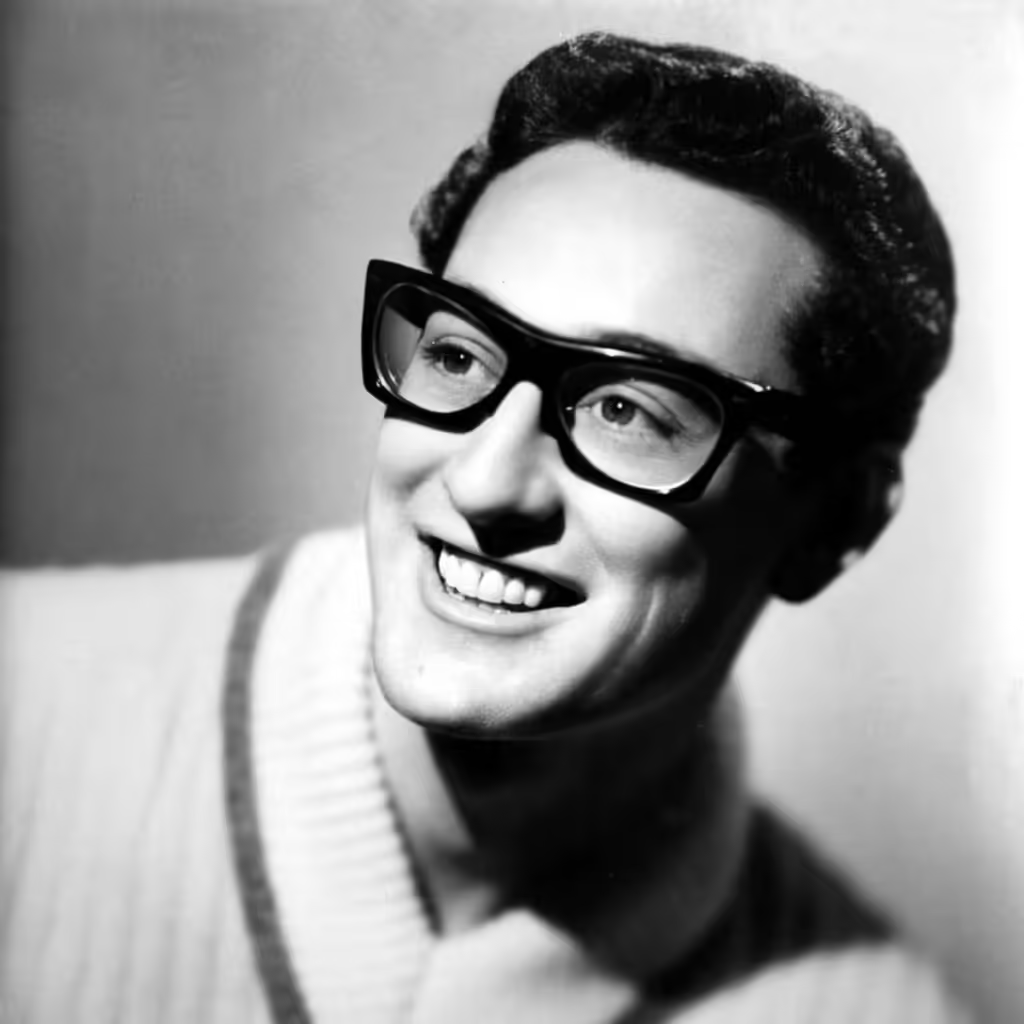
Table of Contents
Who Was Buddy Holly?
Buddy Holly was a seminal American singer-songwriter whose innovative contributions to rock music have left an enduring legacy. Demonstrating proficiency across multiple musical genres, Holly was a seasoned performer by the age of 16. With iconic hits such as “Peggy Sue” and “That’ll Be the Day,” he was quickly rising to fame when his life was tragically cut short by a plane crash in 1959 at the young age of 22.
Early Life
Born Charles Hardin Holley on September 7, 1936, in Lubbock, Texas, Holly was the fourth and youngest child in his family. His mother affectionately nicknamed him “Buddy,” believing his formal name was too grand for her little boy. The alteration of his last name to “Holly” arose from a misspelling in his first recording contract.
From a young age, Holly displayed musical talent, learning to play the piano and fiddle early on, while his older brothers introduced him to the guitar. A home recording from 1949, featuring his rendition of “My Two-Timin’ Woman,” highlights his remarkable singing ability, even at such a young age. Both of Holly’s parents, particularly supportive of his musical aspirations, nurtured his creativity, even defending rock ‘n’ roll in a local newspaper in response to a conservative editorial that criticized the genre and its youth audience.
Despite his family’s encouragement, Holly’s path to becoming a foundational figure in rock ‘n’ roll involved a degree of rebellion. When a local preacher posed a hypothetical question about having $10, Holly’s candid response—”If I had $10, I wouldn’t be here”—revealed his determination to pursue a different future than joining his brothers in their tiling business.
After graduating high school, Holly formed a band and performed regularly on a Lubbock radio station, primarily playing country and western music. He often opened for visiting national acts, marking a significant turning point in his career when he opened for Elvis Presley in 1955. Bandmate Sonny Curtis later noted that Holly’s admiration for Presley led to a transformative change in their musical style. Although Holly lacked the sultry charisma of Elvis, his transition from country to rock ‘n’ roll caught the attention of industry insiders.
A talent scout discovered Holly’s act at a local skating rink, leading to a recording contract. In early 1956, Holly and his band began producing demos and singles in Nashville under the name Buddy Holly and the Three Tunes. The group’s lineup eventually evolved into The Crickets, with whom Holly penned and recorded his breakout hit, “That’ll Be the Day,” in 1957. The song’s title and refrain were inspired by a line delivered by John Wayne in the 1956 film The Searchers. Between August 1957 and August 1958, Holly and The Crickets achieved remarkable success, charting seven different Top 40 singles. Coincidentally, “That’ll Be the Day” reached the top of the U.S. charts exactly 500 days before Holly’s untimely demise.
Solo Career and Untimely Death
In October 1958, Buddy Holly made the significant decision to part ways with The Crickets and relocate to Greenwich Village in New York City. Following legal and financial complications stemming from the band’s breakup, he reluctantly agreed to tour the Midwest in 1959 with The Winter Dance Party. The grueling conditions of broken-down buses in subzero temperatures took a toll on him, leading Holly to charter a private plane for a more comfortable journey from a performance in Clear Lake, Iowa, to the next stop in Moorhead, Minnesota. Tragically, Holly was joined on that ill-fated flight by fellow musicians Ritchie Valens and The Big Bopper. The plane crashed mere minutes after takeoff, resulting in the loss of all lives on board. Buddy Holly was only 22 years old at the time of his death, and his funeral was held at Tabernacle Baptist Church in his hometown of Lubbock, Texas.
Holly’s personal life saw him propose to Maria Elena Santiago, a receptionist four years his senior, on their very first date. The couple married less than two months later in 1958. However, Maria Elena did not attend Holly’s funeral due to her own personal tragedy, having recently suffered a miscarriage. She continues to hold the rights to Holly’s name, image, trademarks, and other intellectual properties.
Holly’s untimely death was poignantly memorialized in Don McLean’s iconic song “American Pie,” referred to as “the day the music died.” Yet, Holly’s musical legacy endured beyond his tragic end. Throughout the 1960s, a steady stream of previously unreleased recordings and compilations of his work were made available, solidifying his lasting presence in the music industry. His distinctive hiccup vocal style and horn-rimmed glasses have become cultural symbols. Despite a professional career that lasted only two short years, Holly’s recorded material has left an indelible mark on influential artists such as Elvis Costello and Bob Dylan, the latter of whom, at just 17, witnessed Holly perform on his final tour. The Rolling Stones achieved their first Top 10 single in 1964 with a cover of Holly’s “Not Fade Away,” while The Beatles adopted their name as a tribute to The Crickets; Paul McCartney later acquired Holly’s publishing rights.
Holly’s influence on pop music extends far beyond individual songs. The Crickets were pioneers of the now-standard rock ensemble comprising two guitars, bass, and drums. Furthermore, Holly was one of the early adopters of innovative studio techniques, including double-tracking, which would become commonplace in music production. Despite these significant contributions to rock ‘n’ roll, a 1957 interview with Canadian disc jockey Red Robinson reveals Holly’s skepticism about the genre’s longevity. When asked if he believed rock ‘n’ roll would still be popular after six or seven months, Holly candidly replied, “I rather doubt it.”
